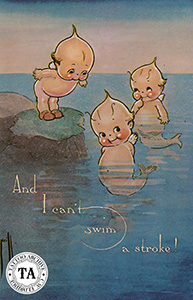Almost single-handedly, Mike Malone brought Kewpie back into the tattoo world. Mike drew a lot of Kewpies which would show up in his production flash. These designs were common in tattoo flash around the early 1900s but in the 1950s, Kewpies were viewed as old-fashioned and they faded from popularity. Kewpie designs can be found on production flash sheets sold by Percy Waters, Milton Zeis and Bill Moore's Chicago Tattoo Supply House.
As with many classic tattoo designs of the past, the Kewpie was taken from popular culture. Created by artist/poet Rose O'Neill, the Kewpie first appeared in the Ladies Home Journal in 1909 and later in children's books that O'Neill wrote and illustrated. The Kewpie was also used in advertisements for Jell-O, Edison phonographs, Kellogg's Corn Flakes, Kodak camera, Colgate Talc Power and many other products.
These illustrations were so popular that soon O'Neill came on the idea of making Kewpie Dolls. It is said that O'Neill wanted to design a doll that resembled a chubby child, complete with a tummy that stuck out. Kewpies have many unique features; most were nude with a topknot hairdo and a red heart was often painted on their chests and tiny blue wings were on their backs. The Kewpie was also noted for its impish smile and eyes that turned to the side. Her creations were called Kewpies because they resembled Cupid, the mythical matchmaker.
Several German companies produced the original dolls that had glass eyes on their bisque faces. These original dolls can be recognized by Rose O'Neill's name on their foot. Throughout the years Kewpies have been produced in celluloid, hard plastic, vinyl, cloth, and chalk --almost any material you can think of. Most Kewpie dolls were nude, but around the 1920s they started being made dressed as firemen, bellboys, cowboys, musicians and American and European soldiers. In 1914 a black Kewpie was made and named Hottentot.
The United Postal Service has twice recognized Rose O'Neill with stamps commemorating her work. In 1997, Scootles appeared in the collection of Classic American Dolls and in the year 2000, Kewpie and Kewpidoodle were featured with 19 other outstanding American Illustrators.
The International Rose O'Neill Club ("IROC") was founded in 1967. Its mission was to preserve and perpetuate the memory and works of Rose O'Neill, and to hold an annual celebration in Branson, Missouri, to be known as Kewpiesta. The Club provides scholarships to aid needy talented students in the area of arts. In keeping with the philosophy of Rose O'Neill, it continues to help others as she helped others in her lifetime. The club hopes to establish a suitable memorial to Rose O'Neill.
Originally published by the Tattoo Archive © 2003
Updated 2017




